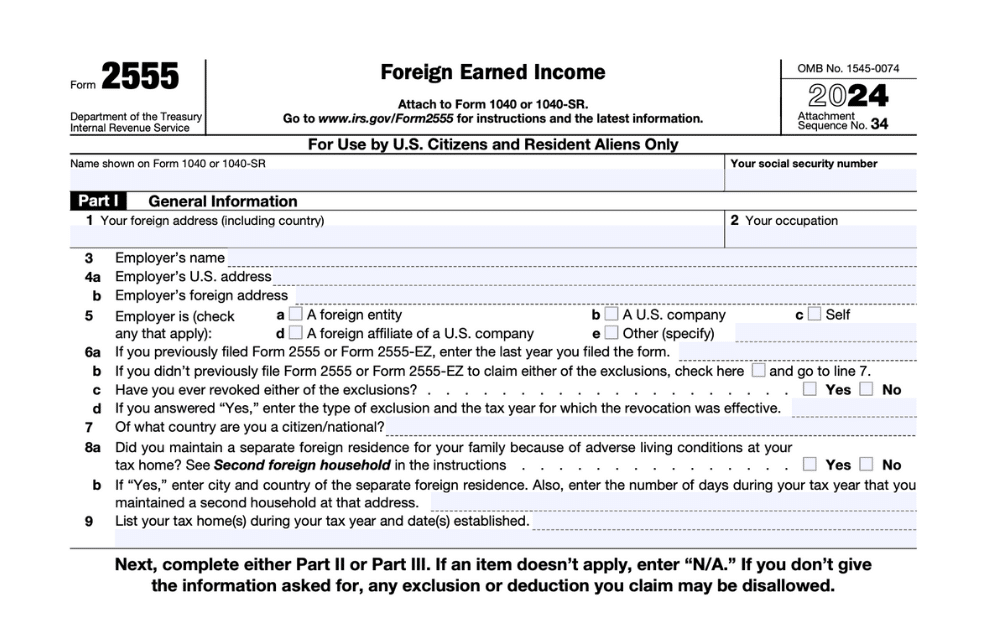Filing Form 2555 for the Foreign Earned Income Exclusion

If you are a US citizen living and working abroad, you can take advantage of the Foreign Earned Income Exclusion (FEIE). This tax benefit lets qualifying taxpayers exclude a certain amount of foreign-earned income from US taxation. Earned income includes salary, wages, and self-employment income. It does not include pensions or investment income.
This exclusion is not automatic. To claim the FEIE, you must complete Form 2555 and attach it to your US tax return.
Key Takeaways
- Form 2555 is a tax form that can be filed by US citizens and Green Card Holders who have earned income from outside the United States and Puerto Rico. It is used to claim the foreign earned income exclusion and/or the foreign housing exclusion.
- You can use this form if you plan on living outside of the country for an extended period of time (generally for 330 days or more.)
What Information Do I Need to Complete Form 2555?
As with all tax-related matters, adequate record-keeping and advanced preparation make the process go smoothly. To complete Form 2555, you will need to have the following information readily available:
- Employer’s name and address (foreign and US, if applicable),
- International travel calendar, including days you might have worked in the US,
- Prior year Form 2555, if available, and
- Foreign income earnings information.
It’s important to remember that Form 2555 must be completed for each expat. If a husband and wife each live and work abroad, both are required complete a separate Form 2555 and attach the two forms to their joint US tax return.
Even though much of the above information will be the same if they live and travel together, the IRS will consider each FEIE claim separately.
Use our simple excel calculator to get an estimate of how the foreign earned income exclusion will save you money. It will make your day!

Are You Eligible For Foreign Earned Income Exclusion?
To be eligible to claim the FEIE on your US expat taxes, you must meet one of the two tests: Bona Fide Residence or Physical Presence.
- The Bona Fide Residence Test requires that you live in a foreign country for at least one entire calendar year.
- The Physical Presence Test requires that you are physically present in a foreign country or countries for at least 330 days during any 12-month period. (The 12-month period can be flexible but must start or end within the tax year.
Your tax return due date can be extended through a regular extension on form 4868 or on a special extension form 2350 to meet the requirements of either test.
Dreading the last minute scramble pulling together your tax documents? Despair no more! This simple checklist lists the documents you need to have on hand when preparing to file.

Completing Form 2555: A Step-by-Step Example
To illustrate how Form 2555 works, let’s follow Lauren Expat.
Lauren’s Story
- December 2023: Lauren left her hometown in Montana and moved to Brazil to become a professional samba dancer.
- Early 2024: She started working for a dance company in Brazil, earning 5,125 Brazilian Real (BRL) per week.
- Mid-2024: She traveled to the US for a five-day performance with her dance group.
Since Lauren lived in Brazil for all of 2024, she qualifies for the Foreign Earned Income Exclusion (FEIE) under the Bona Fide Residence Test.
Part I: General Information
This section is straightforward, asking for basic details like name, address abroad, and occupation.
- In Lauren’s case, she could describe her work simply as a “professional dancer,” “samba dancer,” or “dancer.”
Part II: Taxpayers Qualifying Under the Bona Fide Residence Test
Note: If you qualify under the Physical Presence Test, leave Part II blank and fill out Part III instead.
Working in the US While Living Abroad
Any income earned while in the US is considered US-sourced and not foreign earned. This reduces the amount you can exclude.
- Lauren worked in the US for five days and earned the equivalent of $950 USD for that week.
- This $950 is fully taxable in the US.
Attaching a Statement for US-Earned Income
If you report US-based income on Form 2555, attach a statement showing:
- Your name and Social Security Number (SSN) on each page.
- How you calculated the US-earned portion (including exchange rates).
- The exchange rate used (available on the IRS website).
Example Calculation (using a hypothetical average 2024 exchange rate of 5.115 BRL to 1 USD):
| Brazilian Real (BRL) | United States Dollar (USD) |
|---|---|
| Weekly Salary | 5,125 BRL |
| Annualized Salary | 266,500 BRL |
| Amount Earned in the US | 5,125 BRL |
| Foreign Earned Income | 261,375 BRL |
Part III: Taxpayers Qualifying Under the Physical Presence Test
Reminder: If you qualify under the Bona Fide Residence Test, do not complete Part III.
This section requires you to:
- Specify the 12-month period that qualifies. (It doesn’t have to be a calendar year.)
- List the country where you primarily worked.
- Show all countries visited and dates you were in each country.
Part IV: Foreign Earned Income
List all income that qualifies for the FEIE, such as:
- Wages and salaries (excluding US-sourced income).
- Employer-paid benefits (e.g., housing, tuition for dependents).
Part VII: Calculate Your Foreign Earned Income Exclusion
This section determines how much of your foreign income is excluded from US taxation.
2024 Maximum FEIE
- For 2024, the maximum FEIE is $126,500.
Line-by-Line Example
- Line 37: The IRS pre-fills the maximum FEIE ( $126,500 for 2024 ).
- Line 38: Enter the number of days in your qualifying period.
- Because Lauren lived in Brazil for all of 2024, she enters 365 days.
- Line 39: Calculate the fraction of the year you lived abroad.
- Lauren’s fraction is 365 ÷ 365 = 1.000 (100%).
- Line 40: Multiply the fraction on Line 39 by the FEIE limit on Line 37.
- 1.000 × $126,500 = $126,500.
- Line 41: Enter your foreign-earned income (exclude any US-earned portion).
- Lauren’s total salary is $49,400, but she earned $950 in the US.
- Foreign-earned income = $48,450.
- Line 42: Enter the lesser of Line 40 or Line 41.
- In this example, $48,450 is less than $126,500, so Line 42 = $48,450.
Reporting on Form 1040
- Line 1 (Form 1040): Report total wages ($49,400).
- Schedule 1, Line 8d: Enter the FEIE as a negative amount (–$48,450).
- Form 1040, Line 8 (“Other Income”): Reflect the –$48,450 amount.
By doing this, Lauren shows total wages of $49,400 yet excludes $48,450 under the FEIE. The remaining $950 of US-sourced income is taxable at regular US rates.
Still Have Questions on Form 2555? We Have Answers!
We hope this guide has helped you understand Form 2555 and the Foreign Earned Income Exclusion. If you have any more questions about Form 2555 or your US expat taxes, we can help.
Contact us, and one of our customer champions will be happy to help. If you need very specific advice on your specific tax situation, you can also click below to get a consultation with one of our expat tax experts.



